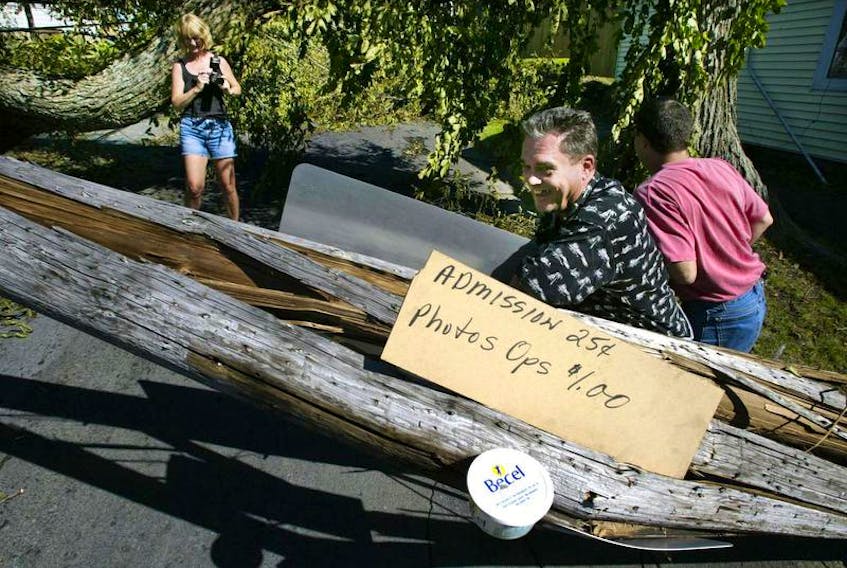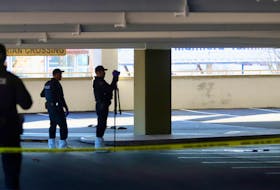It was mild, everyone agrees, on the streets near the old Stairs Rope Works in north-end Dartmouth.
By suppertime, 15 years ago today — assuming you are reading this on Sept. 29 — the wind had started to rise along John and Bligh streets, was starting to rattle the windows of the old cordage worker’s homes on George and to stir the branches of the trees on Pelzant, beneath which Joe Howe once strolled while contemplating his failed campaign to keep Nova Scotia out of Confederation.
That evening Craig Thompson, who had moved into the area in 1980, was with his wife and kids at a little party at a neighbour’s as the Category 2 hurricane whirled towards Nova Scotia.
“I’d seen a couple of hurricanes when we lived in Moncton,” the retired carpenter said when I showed up at his door late this week. “But we really didn’t know what we were in store for.”
The level of worry was minimal enough that some folks in the neighbourhood went out for a stroll as the winds picked up speed, revelling, I imagine, in the demonstration of nature’s power.
But everyone was inside by the time hurricane Juan made land in Nova Scotia at about midnight.
Joyce Hollins, who has now lived at 7 Pelzant for 35 years, happened to look out into the maelstrom that night as a big tree across the street “just lay down.”
At the corner of George and Pelzant, Joann Shepherd feared for her house, even though it had survived the Halifax Explosion. “It sounded like a train was running right by us,” she said, doing a little lawn work in front of her 130-year-old residence the other day.
Shirley Wright lives now, as she did in 2013, in the house across the street. She remembers being “glued to the wall” by the force of the winds that hit 157 km/h.
Somehow she and her late-husband Warren went to bed at about 1 a.m.
When she got up and looked down along Pelzant, the retired Nova Scotia Power employee called what she saw a “war zone.”
Down at the other end of the street, in the Ropeworks Community Garden, I met an older gentleman who had also cast an eye on the aftermath of hurricane Juan.
“Just wow,” said the retired businessman who handed me a cucumber, but declined to give me his name.
Truth is that it was hard to find someone to talk to on Pelzant Street the day I visited, where dozens of orange traffic pylons were lined up along the curb from the just-wrapped shoot for Diggstown, the new CBC television legal thriller.
Nearby, where old trees once stood in this old neighbourhood, there’s a lot of empty space, and cedars and maples that don’t seem much more than saplings
It is hard to picture the scene on the morning of Sept. 30, 2013: The two dozen-or-so hardwood trees piled across Pelzant; the shredded telephone poles; the tangle of power poles and torn-down electrical lines.
The way it was told to me, people just wandered slowly out of their homes into the streets that day to check for damage and to ensure their neighbours were unharmed.
The street was impassable. Kids clamoured over the fallen trunks.
Thompson popped a Corona and, with a buddy, leaned up against one of the fallen trees, a pose that was immortalized in a picture in this paper.
The scene was so devastating that, a few days later, federal defence minister John McCallum — who called the damage “probably the worst thing that’s happened to Halifax since the 1917 explosion”— showed up along with Halifax MP Alexa McDonough to survey the carnage.
Shepherd showed me a few pictures from that day: The reporters — including The Chronicle Herald’s current assignment editor — milling about; McDonough before the television cameras; a telephone pole that took out the power lines across the street from her house; a view up the street which looks like a monster had just passed through, knocking over whatever got in its way.
The lights stayed out in her place for two weeks, during which she and her family decamped for their cottage in Noel, up on the Fundy shore.
While their power was off, the Wrights ate all of their meals out.
The Thompsons, on the other hand, stayed close to home.
Their’s, after all, was a neighbourhood where people looked after each other. So the four of them headed down to the bottom of Pelzant, to Victoria Park, the site of the community garden, to join their neighbours.
People around there still talk about how, 15 years ago, folks brought barbecues down to the park and just left them there.
About how they emptied their fridges of food that was on the way to going bad.
And about how, in the balmy autumn of 2003, until the power went on again, a tight-knit community got a little tighter.









